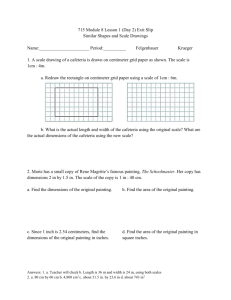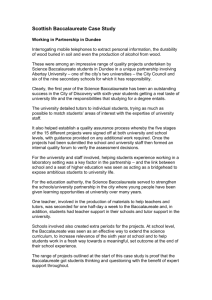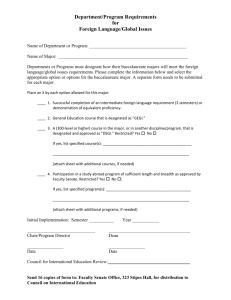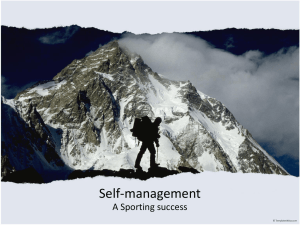Guidelines to Fulfilling the Criteria - MYP Personal Project
advertisement
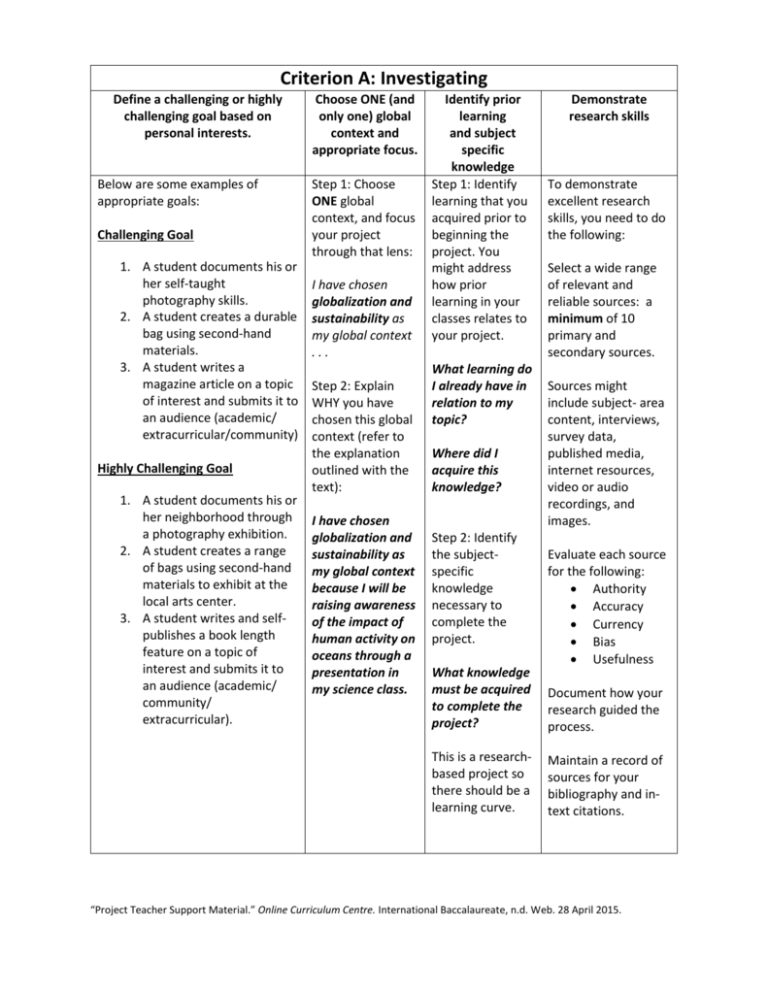
Criterion A: Investigating Define a challenging or highly challenging goal based on personal interests. Below are some examples of appropriate goals: Challenging Goal 1. A student documents his or her self-taught photography skills. 2. A student creates a durable bag using second-hand materials. 3. A student writes a magazine article on a topic of interest and submits it to an audience (academic/ extracurricular/community) Highly Challenging Goal 1. A student documents his or her neighborhood through a photography exhibition. 2. A student creates a range of bags using second-hand materials to exhibit at the local arts center. 3. A student writes and selfpublishes a book length feature on a topic of interest and submits it to an audience (academic/ community/ extracurricular). Choose ONE (and only one) global context and appropriate focus. Step 1: Choose ONE global context, and focus your project through that lens: I have chosen globalization and sustainability as my global context ... Step 2: Explain WHY you have chosen this global context (refer to the explanation outlined with the text): I have chosen globalization and sustainability as my global context because I will be raising awareness of the impact of human activity on oceans through a presentation in my science class. Identify prior learning and subject specific knowledge Step 1: Identify learning that you acquired prior to beginning the project. You might address how prior learning in your classes relates to your project. What learning do I already have in relation to my topic? Where did I acquire this knowledge? Step 2: Identify the subjectspecific knowledge necessary to complete the project. What knowledge must be acquired to complete the project? This is a researchbased project so there should be a learning curve. Demonstrate research skills To demonstrate excellent research skills, you need to do the following: Select a wide range of relevant and reliable sources: a minimum of 10 primary and secondary sources. Sources might include subject- area content, interviews, survey data, published media, internet resources, video or audio recordings, and images. Evaluate each source for the following: Authority Accuracy Currency Bias Usefulness Document how your research guided the process. Maintain a record of sources for your bibliography and intext citations. “Project Teacher Support Material.” Online Curriculum Centre. International Baccalaureate, n.d. Web. 28 April 2015. Criterion B: Planning Develop criteria for the product or outcome. This can be a checklist or rubric. Plan and record the development process of the project. You might consider the following when developing criteria for your product/outcome. You are not required to use all of these, and you are certainly welcome to include other criteria! Planning and development should be documented through your criteria, your process journal, and your report. Process journal guidelines Aesthetics Appearance, style, color, shape, pattern, form, texture, finish, layout You should follow the timeline on journal entry deadlines. Record your entries in ManageBac. Cost Is there a maximum cost? Is this a material cost / time cost? You should include a variety of formats: written entries, charts or graphs, diagrams, drawings, mind maps, videos, photographs, screenshots of a blog or website, bulleted lists, timelines/action plans, interview notes, etc. User/Audience Who it is for? Consider age, gender, socioeconomic background Environmental considerations: How will the design directly or indirectly affect the environment? Function: What is its purpose? What will it do? How easily can it be used/maintained? Materials: What materials will be used? What properties do the materials need to have? Size/Content: Are there any specific sizes that need to be considered? Is there a particular amount of content required? Impact: What impact do I want my product / outcome to have? Your process journal entries should address each of the three strands for each objective: investigating, planning, taking action, and reflecting. At the end of the process, you will select 10 extracts that represent each stage of the process. These extracts will be submitted as an appendix to your report. You can annotate each extract to make it clear which stage in the process it addresses. The process journal is NOT . . . Written after the project is completed; it should support the process and completion of the project A daily diary entry that details every part of the process Demonstrate substantial or excellent self-management skills. Self-management should be evidenced through the process journal and report, through adherence to deadlines, and through interactions with your supervisor. Self-management skills can be demonstrated by . . . Meeting project deadlines Maintaining an organized/logical system of information Planning strategies to guide your inquiry Planning and managing activities to develop a solution or complete a project Structuring information appropriately in written, oral, and visual work Demonstrating patience and perseverance Seeking out criticism and feedback from others and making informed choices about including it in one’s work Making informed choices on behaviors and choice of action Practicing focus and concentration to overcome distractions Pausing to reflect at different stages of the process Keeping a reflective journal of personal learning experiences focused on both process and content “Project Teacher Support Material.” Online Curriculum Centre. International Baccalaureate, n.d. Web. 28 April 2015. Criterion Action CriterionC: D:Taking Reflecting Evaluate the quality or Create product or outcome. outcome of the product. Reflect on what you learned Demonstrate development of . . . Demonstrate thinking skills. Demonstrate communication and about the topic and the 1. Approaches to Learning skills social skills. global context 2. IB learner traits Your or outcome should Step Examples of thinking skills Communication skills will be we Onceproduct the product or outcome 1: Through the personal Considering both the ways in which reflect your goal, global context, include the following . . . demonstrated through your is complete, you will evaluate project, you have learn (Approaches to Learning) and and criteria. communication your supervisor it against the criteria investigated a topic who we strive to be aswith learners (IB Critical Thinking Skillsof andProfile) your mentor and through your (specifications) that you personal interest to you. Learner can help us appreciate Identify problems and Goal: My goal is to learn more about report. created at theand beginning of the developjournals aims, goals and and our strengths and identify areas to Japanese culture then express my In your process objectives process. at the end of the process in improve. findings in a painting. Communication skills might include . . . Make Global Context: Personal and cultural the report, youinferences need to and draw Organizing information logically conclusions expression You should have a complete reflecton Identify what you have Approaches to Learning Making effective notes gaps in knowledge Criteria: Using a variety of speaking Thinking and 1. critical evaluation of the learned about your topic. and formulate key questions The painting must represent techniques make meaning clear critical thinkingtoskills quality of You should include many Plan to achieve goals, allthe partsproduct of Japanese art: for different audiences and creative thinking skills including identifying targets /outcome against eachclothing, of the specific examples to poetry, painting, purposes transfer skills and outlining steps and architecture. criteria that you set. demonstrate what you have Using appropriate forms of writing Identify obstacles and 2. Requires a poem that learned. challenges for different audiences and Self-management represents the painting. purposes skills Be sure include details organization Consider ideas from other 3. to Canvas around 20 inches by Using(social/emotional) a variety of media to present affective skills and points about your achievements, as Step 2: At perspectives the beginning of of 40 inches. to an audience view (Student might have included additional the process, well as possible you chose ONE Giving and receiving appropriate Break large concepts Research criteria, such as time period, art improvements. global context. down In your feedback and projects into components information literacy skills medium, and poetry style.) process journal and in your Structuring information correctly in parts and combine parts media literacy skills essays, reports, or presentations You might consider the report, you should reflect on logically as appropriate Product: A Japanese historical canvas following for each criteria: what new knowledge and painting. Social Social skills might include . . . Creative Thinking Skills collaboration skills understanding you gained Considering, respecting, and old ideas in new ways Goal: provide blankets How To does the fleece product or to the about thatUtilize global context. analyzing different opinions, points and combine parts in new homeless shelter Communication outcome’s quality measure up You shouldways include multiple of view, ideas and preferences Global Context: Fairness and communication skills to my criteria? examples. Respecting different opinions of Consider all alternatives development Criteria: 1. did 25I blankets and scarves from What do well? leftover material 2. Scarves = short and different If I couldcolors do it over, what would 3. I do Thedifferently? material needs to be fleece for both blankets and scarves 4. The price of one fleece blanket kit is around $12, but I purchased the kits for $8 each during a winter sale. 5. The size of the blankets will be 80 X 60 (Are there other specifications that the student could have included?) Final Product: 20 blankets and 5 scarves others Generate “what if” questions Traits Taking responsibility for own Transfer and apply existing IB Learner actions to be . . . knowledge to generate newIB learners strive Resolving conflicts and work ideas, products, or processes inquirers collaboratively with appropriate Brainstorm and map thoughts knowledgeable roles on a team to create ideas and questions thinkers decisions based on fairness Create original works or Making communicators and equality. practice imitation of works principled with a focus on creative open-minded process find caring You can a complete list of thinking, reflectiveand social skills at communication Transfer Skills balanced smmhspersonalprojectguide.weebly.com. Make connections between reflective knowledge gained in different subject areas Transfer current knowledge to Source: “Project Teacher Support Material.” Online Curriculum Centre. learning new technologies Make decisions Use your knowledge, understanding and skills across subjects to create products or solutions. “Project Teacher Support Material.” Online Curriculum Centre. International Baccalaureate, n.d. Web. 28 April 2015. “Project Teacher Support Material.” Online Curriculum Centre. International Baccalaureate, n.d. Web. 28 April 2015.




